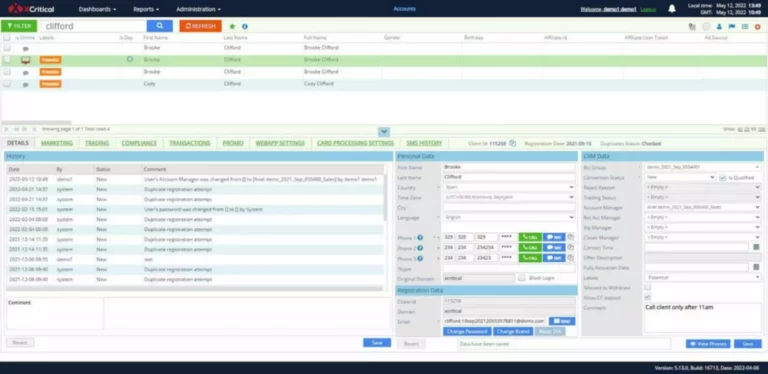Trading Platform Design: What People Often Get Wrong in UX UI
Content
M1 Finance also supports fractional shares and automated deposits, which is Decentralized autonomous organization good for diverse investment strategies. Besides, it offers educational resources and a straightforward sign-up process as well. The platform’s user-friendly interface is well-suited for traders who value an uncluttered experience without sacrificing access to essential tools. Too often, businesses try to be all things to all people and can end up looking like a poor amalgamation of all their competitors.
FinLab – NodeJs Crypto Trading Admin Dashboard Template
The clean, minimalist mobile-first interface is intuitive for beginners, with features like fractional share investing and instant funding making the process accessible. Our team has carefully chosen the following trading platforms for their features, user-friendly designs, and https://www.xcritical.com/ ability to cater to different types of investors, from beginners to experienced traders. Another thing to keep in mind is that while there has been a broadscale switch to mobile, this doesn’t mean that your interfaces should be optimized for mobile alone. Nowadays, your users will access your platforms via smartphones but also laptops and tablets, as well as a new generation of tablet/laptop hybrids (e.g. Chromebook/Surface), all with slightly different UX considerations. Traders spend a great deal of time fiddling with their charts, so you must ensure that it’s an intuitive and responsive experience for them. Interactive Brokers (IB) is designed for serious traders, so it’s more focused on offering a rather deep and sophisticated platform.
Trading Platform UX/UI: Overhaul Your Design with the Latest Trends
In the industry’s early days, a premium was placed on making trading platforms look as complicated and “professional” as possible. This platform-centric approach has been a game-changer for many trading platform design financial services businesses. It contributes to a much easier and more pleasant experience for clients while also allowing businesses to consolidate all the important data collection and monitoring, which is so crucial nowadays, to one centralized platform. Lastly, TradingView is known for its great charting capabilities and social trading features.
Paysa – UI kit for FinTech and Banking Apps
We hope that the solutions and examples presented in this pair of articles have given you some ideas regarding utilizing the resources available (data & human expertise) when thinking about how to tailor the look and feel of your platform. Successful UX/UI design choices that start life off in the above manner eventually allow you to serve your clients better and help you stand out in a crowded market of cookie-cutter trading platforms. As mentioned in the previous article, your platform is the flagship of your business; it’s where your clients will spend most of their time, and it’s also what new registrations want to get their hands on as soon as possible.
- Our team has carefully chosen the following trading platforms for their features, user-friendly designs, and ability to cater to different types of investors, from beginners to experienced traders.
- If this is the case, then not only does your business have the most knowledge and experience regarding this area of the asset universe, but so, too, do your team members.
- It’s an extremely simple but incredibly effective solution that can be accomplished by creating two separate platform layouts and allowing clients to easily switch between them.
- Trading platforms have evolved over the years to take a form that traders recognize and find most efficient for charting and trading purposes.
- Read on to see how trends like nostalgia, physicality, storytelling, and many more will shape the 2025 graphic design stage.
Crypto Planet – Crypto Trading Exchange UI Template In Figma
These details can be incorporated to really tailor the first impressions your platforms provide to first-time users, as well as gently steer them in a direction that the business has concluded is optimal. We’re all familiar with the overly busy assortments of windows, tabs, sidebars, and menu options designed to make trading platforms look like they can successfully land a Mars rover while also executing trades with minimal slippage. For these reasons, it’s imperative that if you have a trading platform that you’re proud of, you want prospective traders to get their hands on it as soon as possible and to be able to experience for themselves what trading with your firm will be like. We understand that the larger multi-asset market is what every trading business wants to aim for, but usually, there’s an asset class (or sometimes even a single instrument) that the lion’s share of a trading business’s clients are interested in.
We understand that you have your third-party subscriptions that you want to make the most of, as well as your existing client communication strategies, and that you may also want to offer your own in-house trading data to your clients in an engaging manner, but sometimes less really is more. It’s the place where your clients will spend the most time, and it’s also the place where the lion’s share of your revenues will be generated. The aim is to get you thinking about the experience your existing user interfaces offer your customers, as well as how these can be improved to make your services more attractive, quick to convert, and sticky once the client is there.

You cast a wide net to attract as many interested visitors as possible to your various offerings. But a big part of this numbers game is thinking very carefully about how prospective clients drop off at every step on the way to becoming full-fledged clients with funded trading accounts. For example, for traders of equities, some kind of user-defined stock screening functionality is probably far more useful than a generic heatmap and newsfeed. Likewise, FX traders value correlation data regarding the currencies they trade over some of the more conventional data choices that brokers have on offer. It’s all about knowing the subtle differences between trading workflows across the asset landscape and tailoring your data provision to these subtleties.
This seems to have been the governing design principle in trading platform design for the better part of twenty years. But again, consider that you’re dealing with new generations of traders who are native smartphone users and have grown accustomed to interacting with highly efficient, very well-designed user interfaces in all the other apps they frequently use. This is why some of the biggest names in online trading have been migrating to a much more user-friendly approach where simplicity is key but also where advanced features and the full power of your platform can be accessible at the tap of an icon when a client wants to experience all the possibilities. The look and feel of trading platforms haven’t evolved all that much in recent years, largely because of a logic of not wishing to reinvent the wheel or fix something that isn’t broken.

The platform’s layout is user-friendly, visualizing portfolios through easy-to-understand pie charts. The platform’s design also supports extensive customization, allowing users to create and back-test trading instruments using diverse datasets. The platform makes it easy to work with diverse datasets, backtest ideas, and analyze risk – all in one place. Along with some useful first-hand design tips, we have compiled a list of ten best trading platform design examples in 2024 that have come very close to creating a perfect trading experience. If you’d like to discuss any of the issues raised above or see how we can improve the user experience you’re currently offering your clients, please don’t hesitate to get in touch.
For this reason, when trading businesses have an opportunity to make changes (for example, when overhauling their client-facing interfaces), they tend to play it safe. Fidelity’s platform is characterized by its simplicity and accessibility, which is particularly appealing to those new to trading. The interface is clean and organized, so it’s easy to navigate the wide range of investment options. The platform’s educational resources are integrated into the interface, which is perfect for new investors. Despite its simplicity, Robinhood provides advanced charts and tools for more experienced users,and that makes it an another versatile platform with a great design.
The top 10 platforms featured in this article demonstrate the importance of balancing functionality with usability, providing a seamless trading experience that sets them apart from the rest. Quantango’s platform has a minimalist design and an aesthetic that feels modern and appropriate for a tech-driven platform. The interface is clean and intuitive, with a sectioned layout and smart use of negative space for effortless navigation.
This time, we’d like to focus on some contemporary trends and design best practices that are proven remedies to the above issues. Like in the previous article, we’ll take these issues one by one and explore what you can do to solve them and transform your business into a financial services powerhouse. Speaking from experience as a SaaS and Fintech design agency, many online trading solutions are far from intuitive. Trading platforms have evolved over the years to take a form that traders recognize and find most efficient for charting and trading purposes. In this series of articles, we want to share some of these insights, as well as a little of the secret sauce that we feel separates the most successful trading firms from the rest of the pack.
It’s an extremely simple but incredibly effective solution that can be accomplished by creating two separate platform layouts and allowing clients to easily switch between them. As another example, in the early days of cryptocurrency trading, crypto exchanges recognized that the ability of users to chat between themselves (as in the infamous “troll box”) was a far more useful addition to their rudimentary trading interfaces than any other kind of data presentation. Crypto trading was a largely socially driven phenomenon, so it benefited these businesses to have users spread ideas, resources, and even knowledge between themselves rather than trying to guide the process in any concerted way. This proved to be a very effective solution and perhaps one of the stickiest UX/UI development decisions made by any trading business.
You don’t want your app to offer the clunkiest experience on your client’s home screen. Keep in mind that a large percentage of incoming prospects may be new to trading or may have never placed a trade in their lives. The most successful players in the industry manage to strike a balance between simplicity at first glance while having the option to easily switch to a “full” version of what they offer. Later, MT5 builds upon this foundation with a more contemporary design and expanded analytical capabilities.
The platform’s intuitive interface seamlessly integrates advanced technical indicators and a collaborative community-driven approach. Although it can be quite overwhelming for beginners, the platform’s extensive educational resources, competitive margin rates, and access to a wide range of asset classes make it an appealing choice for those seeking a professional-grade trading environment. So, keep it simple, keep it clean, and ensure that every bit of data you offer your clients is part of an overall trading workflow that supplements their primary activity rather than offering a distraction from it. Are your customers diehard chartists, or are they more likely to buy or sell at the market without needing to draw lines all over the place?